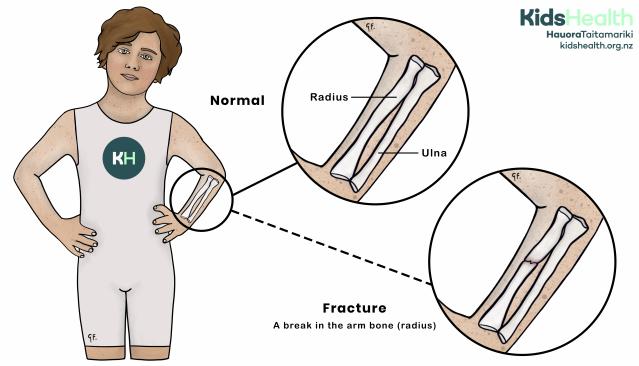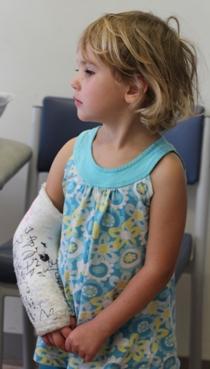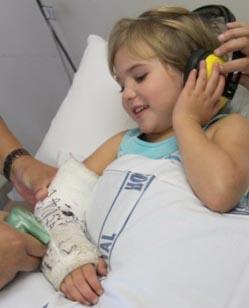Key points about your child's arm plaster
- tamariki (children) with fractures (broken bones) need plasters and splints to prevent the bones from moving
- plasters and splints allow a fracture time to rest and heal
- plasters and splints help to reduce pain from your child’s broken bone
- if your child has a cast or splint, they will need follow-up appointments
What plasters and splints do
Tamariki with fractures have plasters (also called casts or plaster casts) and splints to prevent the bones from moving. This allows the fracture time to rest and heal. Plasters also help to reduce pain from a broken bone.
What is a fracture?

An illustration comparing a healthy arm with one that has a fracture in the radius (the main bone in the forearm).
Source: KidsHealth
transcribeTranscript
The illustration shows a child standing with hands on hips, wearing a white outfit with the KH logo on the chest.
Two circular close-ups of the child’s forearm are connected by dashed lines:
- The top circle is labelled Normal and shows a healthy arm bone with the radius and ulna sitting side by side.
- The bottom circle is labelled Fracture – A break in the arm bone (radius) and shows a visible crack in the radius bone.
At the top right is the KidsHealth logo with the website: kidshealth.org.nz.
A fracture is a break in a bone. There are many different types of fractures that all have different names.
Waiting for a plaster to dry
An arm plaster cast takes 24 to 48 hours to dry completely.
In the first hour or two, while your child is waiting for their plaster to harden, it is a good idea to rest their arm on something soft, such as a pillow or sling. Hard surfaces may damage your child's plaster.
Caring for your child while they have an arm plaster
The following guidelines help you care for your child while they have their plaster on.

Source: KidsHealth and Starship Child Health
Support the plaster
Rest the plaster on something soft until it’s dry. When sitting or lying down, use a pillow to rest the plaster. Keep the arm raised to prevent swelling, especially for the first 24 to 48 hours.
Support the arm in a sling or collar and cuff (soft straps that go around your child’s neck and wrist). Ask your health professional how long your child will need a sling for. Do not keep the sling on longer than instructed.
Check your child’s hand and fingers
Check the colour of your child's fingers. Their fingers should be pink, and if you gently squeeze the fingernails and then let go, they should quickly return to pink.
Make sure your child moves their fingers often. Encourage them to gently move the joint above the plaster (their elbow or shoulder) to avoid stiffness.
Watch for swelling. Compare it to the other hand - are they about the same size? If it looks swollen raise the arm above the level of your child’s heart on pillows to help reduce the swelling.
Keep the plaster clean and dry
Keep the plaster clean and dry. Check around the plaster for any smells - plasters do have a slight smell, but have it checked if you are worried.
See a health professional
Don't cut or remove the plaster - see a health professional if your child’s plaster is uncomfortable. See a health professional if you are worried.
If you have a fracture clinic appointment, remember to take your child's sling, even if your child is not using them at the time.
Things to avoid with an arm plaster
Avoid getting it wet
Do not get the plaster wet. Try not to knock or bump the plaster.
Let the plaster dry naturally. Do not use hairdryers or other drying equipment to dry it - they may burn your child or crack the plaster.
Do not press or write on the plaster for 24 to 48 hours until dry - pressing on it will dent it.
Do not put things in or around the plaster
Don't poke anything, such as knitting needles or other sharp objects, down the plaster. It may damage your child's skin.
Avoid putting lotions, creams or powder inside the plaster or around the edges.
Bathing your child with their arm plaster
- wrap a towel around the plaster
- place the arm in a plastic bag large enough to cover it completely
- secure the end with tape (such as cellotape)
- there are also some special coverings for plasters - ask a health professional about these
- don't put the arm in the bath - rest it on the edge of the bath
- don't aim the showerhead at the affected arm
When to get medical help for your child with an arm plaster
After going home, you should take your child back to the emergency department or contact your doctor urgently if your child:
- complains of pain that is getting worse even with pain relief and raising the broken arm
- has a hand that is going cold, pale or blue
- has a hand that is becoming more swollen
- complains of fuzziness, numbness, pins and needles or tingling in the fractured arm or in their fingers
- cannot move their fingers
If your child's plaster becomes cracked, broken, soft or loose, or rubbing, contact your health professional.
Follow-up for arm plasters
Yes. It is very important that your child goes to all their follow-up appointments.
Your child will usually need a fracture clinic appointment 5 to 14 days after leaving hospital. At this appointment, your child may have another x-ray to make sure the bone is healing and is in place. Your child will usually need several more appointments at a fracture clinic to make sure the break is healing.
Ask a health professional for instructions for your child's follow-up before you leave hospital.
Removing an arm plaster

Source: KidsHealth and Starship Child Health
When your child's injury has healed, the plaster will be removed. This is done with specially designed plaster shears or a saw that can cut through the plaster but not the skin.
Plaster removal is a fast and painless process but can be very noisy!
Returning to physical activity after an arm plaster comes off
Your health professional will tell you how much physical activity your child can do while their injury heals. After the plaster comes off, your health professional will guide you on when your child can go back to various activities.
Acknowledgements
Illustrations by Dr Greta File. Property of KidsHealth.
